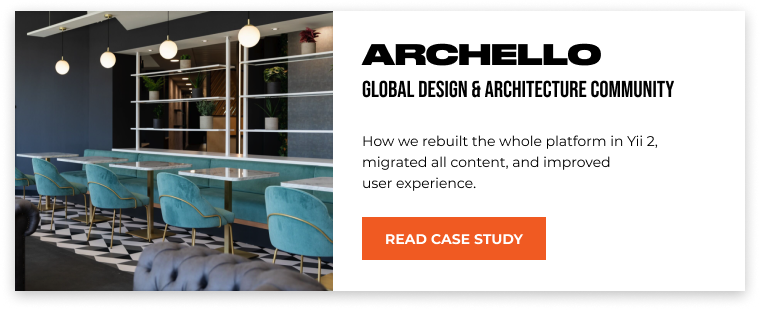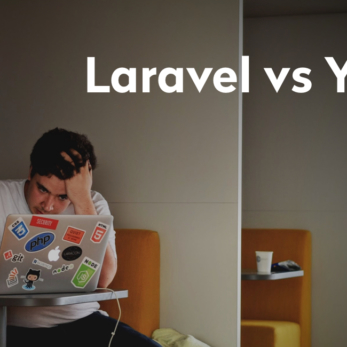Scalability is one of the most critical conditions for the success of a web application. In this article, we will tell you what to keep in mind during the development to meet the principles of scalability:
- what can limit the structure of a sustainable and scalable web application;
- what technologies embody the idea of scaling to life;
- how to develop an app that will withstand the visitors’ inrush on the crest of a success wave and painlessly transfer the expansion of functionality at any development and operation stage.
Where to begin a scalable development? To better understand the underlying principles and highlight the advantages of this approach, we will cover various related concepts, types of application architecture, and popular frameworks.
What you will learn:
Why does one need scalability?
Looking at the websites of the frontline companies, we don’t always realise what kind of workload they are to withstand. Neither do we think about the importance of high productivity and usability for the success of the company.
Therefore, when the newcomers start building their first websites, they don’t know about some problems they may run into later:
- an increase in the number of visitors reduces the performance of web applications and blows up the failures;
- expansion of the product range negatively affects the page load time; updating the inventory of an e-commerce shop becomes problematic;
- changing the code structure becomes dangerous and overcomplicated; adding a new product or service take too much time and becomes expensive, and the possibility of carrying out the A/B tests reduces.
As a result, the business has wasted opportunities if the problem hasn’t been solved, and the restrictions persist.
Do all websites inevitably face such problems?
To one extent or another, most of them experience such issues. However, the degree of their complexity depends on how well the web applications were designed from the very beginning.
Scaled development is not a special kind of development. It’s a set of principles and techniques that help you design an application to a high standard.
By sticking to specific rules of the application setup, you will be able to:
- reduce the page load time, number of errors, time to implement changes, and the cost to update the site;
- improve the user experience;
- extend the life cycle of the services or products offered;
- as a result, increase sales and brand loyalty.
What is scalability?
The website scalability definition is the ability of a system, network, or process to cope with the increase in workload when adding resources (usually hardware).
Scalability can be assessed through the ratio of the increase in system performance to the rise in resources used. Also, scalability means the ability to add extra resources while keeping the structure of the central node intact.
In a system with poor scalability, adding resources leads only to a slight increase in performance, and after reaching a certain threshold, boosting the resources does not have any effect at all.
In addition to scalability, there is a number of related concepts that help better understand the problem. One of them is recoverability.
Recoverability is the ability of the system to restore its operability after a failure. It is closely related to the concept of a saturation point.
A saturation point is a certain degree of the workload intensity at which the system begins to malfunction. Unjustified jumps in the operation of the system usually lead to failure.
Under normal conditions, the program’s performance changes proportionally to the load, which increases gradually. If at some point the predictable growth is replaced by abnormal jumps – the saturation point has been reached.
Testing aimed at identifying this point is called a ramp-up test. It helps to determine the reliability and scalability of a web application, as well as identify the system bottlenecks that undermine the effective operation of the entire system.
What characteristics affect the web application scalability?
- Architecture. This is one of the most important parts of app scalability.
- Framework load. Sometimes scalability is limited to the framework, so its choice affects the performance of an app with the increase of features.
- Sustainable design. The quality of code also significantly affects scalability.
- Sustainable load testing. With proper load and performance testing, you’ll be able to find and eliminate the bottlenecks of your app and ensure its smooth growth.
- Hardware limitations. As you see, not only software can affect scalability.
- Third-party component integration. It is the most widespread cause of bottlenecks and failures in operation.
Scalable app architecture
We’ve just discovered that the app architecture makes a big difference in scalability. Now, let us go into details of how a scalable app should be designed.
Frontend vs Backend
A frontend is the visible part of a web application the user interacts directly with.
In the software configuration, many levels between the hardware and the end-user may exist. Each of them can also have a frontend and a backend.
The frontend is an abstraction that provides a user interface. For example, open a new tab of the browser, type the address of some website, and press Enter. The website should load instantly. A well-designed page template is understandable, and the visual component is impressive, simple and easy to navigate.
However, in addition to being easy to use, a properly designed frontend also helps avoid problems with scalability in the future.
Backend stands for everything that happens on the server. It interprets everything the user does on the frontend, communicates it to the database if necessary and sends a response back to the browser.
This part takes up to 80% of the entire code and affects the performance of the whole application the most.
Backend is responsible for the dynamic processes on the page and data storage management, which makes it more prone to bottlenecks. The backend can be built with any multifunctional programming language like Javascript, Python, Ruby, C#, etc.
Multitier scalable web application architecture
A multi-tier model is a software model that should contain three components: the client, the application server the client application connects to, and the database server to run the application.
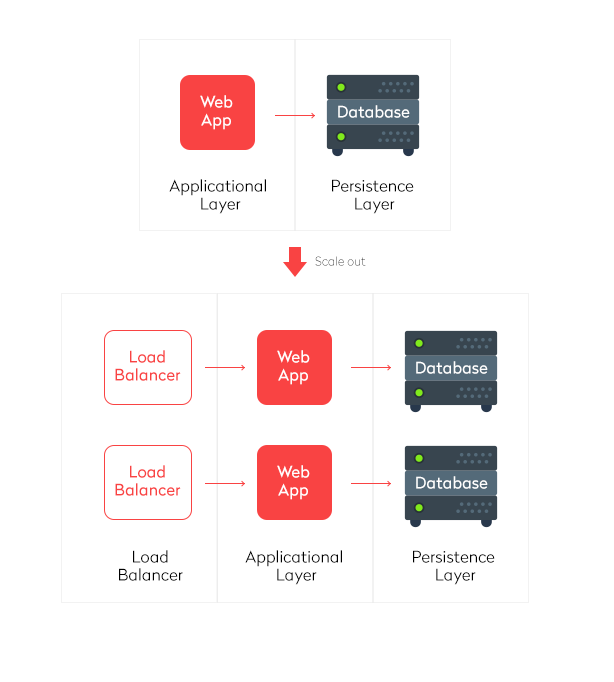
Each layer of such an application should perform only the most essential functions, thereby improving performance and scalability greatly.
The multi-tier architecture is to implement two basic principles:
- minimise the functionality of client components, leaving the client only the functions of the user interface; maximum simplification and unification of the client software;
- unload the database server from functions it shouldn’t run.
Such architecture distributes the processing modules more intelligently, which in this case are performed on one or several separate servers.
These software modules perform server functions for interfaces with users and the client for database servers. Besides, different application servers can interact with each other to separate the system into function blocks with specific roles more accurately.
Vertical vs horizontal scaling
Vertical scaling implies a performance increase of each system component to improve overall performance.
Scalability, in this context, means the ability to replace the components of an existing computing system with more powerful and faster ones as requirements grow, and technology develops.
It is the easiest scaling approach since it doesn’t require any changes to the application programs running on such systems.
Horizontal scaling is when you separate the system into smaller structural components, space it across individual physical machines, and increase the number of servers that execute the same function simultaneously.
In this case, scalability is the ability to add new nodes, servers, and processors to the system to increase overall performance.
This scaling approach may require changes to the programs so that they fully utilise the increased amount of resources.
Popular scalable web app frameworks
These are the tech stack options to explore while designing scalable web applications:
- Node.js
This technology is considered to be the best for scalable and asynchronous programming to date.
It can handle multiple requests at a time without any disruptions and failures. This outstanding Javascript framework eliminates waiting while providing a single-threaded, non-blocking, asynchronous programming, which is very memory efficient.
Also, it provides numerous packages with useful features optimising the work even more. You can learn more about this framework at its official web page.
- Django
This high-level and extra fast Python web framework supports the clean and pragmatic design of the applications which contributes to the scalability as well — see a detailed list of its advantages.
Continuous development from the concept to launch seems favourable for every startup, while reliable security helps to avoid many serious mistakes.
- Ruby on Rails
RoR is familiar to everybody who uses Shopify, Airbnb, ZenDesk, GitHub, and many other popular platforms. It is known as the framework allowing to build a web application 30% faster than others while providing the same quality.
However, if compared to Node.js, it has less capacity to run many complex asynchronous queries at a time.
In addition to the frameworks mentioned above, you can try Asp.net, Angular JS, React.js, Yii or Laravel.
Scalable web app principles
So, when you ask yourself how to build a scalable web application, make sure that the following principles form its basis.
- Smooth performance
In addition to availability, the application should have high performance.
Otherwise, you risk getting an adverse reaction from customers and reducing the position of the website in search results — Google indexes such sites worse.
Thus, a web application with low performance is unlikely to be able to deter a serious audience.
2. Continuous availability
For companies, it is vital that their web application is available all the time. Every minute it becomes inaccessible causes significant damage to the company’s profits and reputation.
For SaaS and cloud solutions, it’s crucial to ensure interrupted lifelong access to services.
Therefore, it is necessary that a scalable website be accessible at any time of the day and from any place where your user can apply for the service.
3. Fast data retrieval
Working with data usually involves many performance problems.
The fact is that third-party technologies are usually used for storing and accessing data, and their integration is an intractable task.
At the junction of the main app part and database services, you can often find bottlenecks.
Your responsibility is to avoid this problem in your project.
4. Malfunction traceability
The system has to be easy to operate, maintain, and update.
Besides, all the problems that may arise already at the stage of product functioning should be easily traced and corrected.
Good results are achieved by proper structuring and segmenting the application into relatively isolated parts.
5. Real-time response
Of course, the speed of your online application is important. It concerns not only the data retrieval on the storage or overall performance but also the speed of operations and response.
No matter how useful your application is, you only have a few seconds to meet the customer’s needs.
If you do not keep within this time, the client would instead go to the competitors.
Examples of top scalable applications
Indeed, you’ve heard about these fantastic web applications for businesses and individuals.
1. Evernote
Evernote is an indispensable helper when it comes to managing tasks and meeting deadlines.
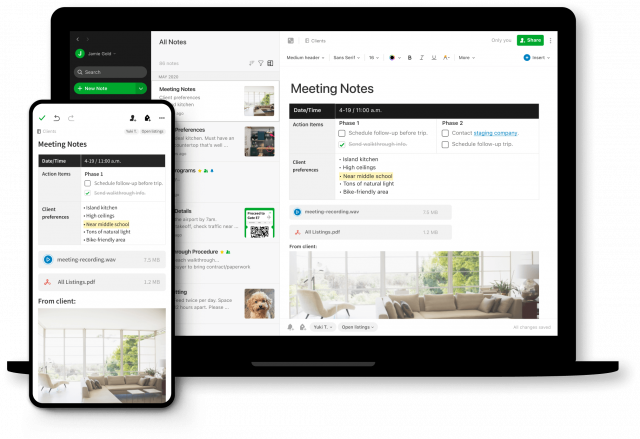
It offers opportunities for both businesses and individuals. With the Evernote app, it is easy to make notes, memorise essential things, create to-do lists, and collaborate with teammates.
2. Bitly
It is the Bitly app that has brought optimised links to the digital realm.

The application helps businesses harness the potential of links to improve interactions with customers, build brand awareness, and monitor business performance.
For better results in link management, Bitly provides users with data collection and real-time analytics.
3. Mint
If you’re planning to build scalable web applications for financial purposes, have a closer look at Mint.
Mint is a budgeting app of a new generation.

Among the core features of the Mint app are budget management, credit score assessment, investment consulting, bills tracking.
The app is very customisable and secure: it enables users to set their custom alerts and notifications and use high encryption levels to protect personal records.
4. Dropbox
Dropbox is the best-known app for sharing files and business collaborations.
It comes in a bundle with enterprise-ready performance and controls feature and Dropbox Paper.
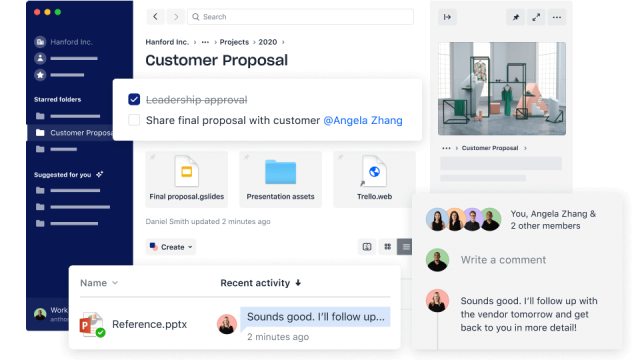
The former solution makes it possible to keep business data securely; the latter enhances teams’ collaboration by bringing it to one place.
Among the Dropbox users are Expedia, Spotify, National Geographic, and other famous names.
5. Slack
Slack is the communication tool we love at JustCoded and is another example of scalable web design!
The application is intended for connecting employees of any startup or established business.

Slack is rich in features that simplify all the aspects of teamwork:
- channels help you arrange discussions;
- with the searchable story it is easy to find the necessary info;
- video calls and screen sharing take personal communications to a new level.
Scalable design methods and strategies
When developing and designing a scalable application on the web, the following techniques will help you:
- Independent features & nodes functioning
Here we mean Service-Oriented Architecture (SOA), in which each service has its functional context and should not affect other services.
Each part of the application should deal with its business and be competently linked to other services.
The emphasis is not on speed and simplicity of development, but on structural integrity, which in the future will save a lot of time and effort aimed to maintain the old structure.
As a result, problems will be quickly isolated; the issues of one function won’t affect the others; there will be no competitiveness between functions during the growth process, etc. The same concerns the nodes of the app, as well.
- Load balancers
Load balancers are crucial for scalable web applications as they distribute the load when the number of simultaneous connections increases, distribute connections to nodes.
It enables service performance increase due to the nodes adding. The load balancer will distribute the loads according to the criteria that have been set up.
You may use several load balancers to tackle complex systems. Caches and cookies applied simultaneously with load balancers will help eliminate the problems with the same requester that may be routed differently during ensuing visits.
A right solution for load balancing is Nginx, which processes load distribution in Node.js.
- Caches
There are several ways to accelerate request retrieval. Caches are the most widespread solution, which won’t harm but enhance your platform.
The idea is that the query, which was performed earlier with a high frequency, will be executed again with high probability. Thus, we can create a small repository for quick access to the results of frequent queries and shorten the waiting time for the user to respond.
The cache is used at different levels of the application, but in the best way, they are embodied in the following places:
✓ You can insert the cache on the requesting node to make the data retrieval almost immediate for your customers. The more nodes your app will have, the more caches there will be, as each node should have its cache.
✓ The global cache is used if there is a need to create one general cache for all the nodes and thus avoid numerous misses.
✓ The distributed cache provides the data piece distribution throughout all the nodes. The more data is cached closer to the user, the faster it is retrieved.
- Proxy
The main advantage of the proxy when it comes to scaling is multiple server requests coordination.
It can collapse the multiple identical requests into one and lessen the queries to the database disk. Thus, both the response time and database performance increases.
The best practice of using proxies is by combining them with caches. In such a case, their use is estimated to be the greatest.
- Indexation
Indexes are closely connected to the data retrieval in case it’s spread out among physical devices. They allow finding a small piece of information in a vast data set quickly even if it’s distributed among many physical devices.
To implement a quick search, you use index tables based upon where that data is housed. Although the query is added to the search and the table, the user will receive a response faster due to indexing.
Despite the apparent advantages of this approach, with a substantial increase in the data volume, the tables become too cumbersome. Therefore, use them prudently.
- Queues
With the growth of the web application, the procedure for writing and processing requests may become slower.
Also, there is a need to regulate concurrent requests and handle a large number of them.
In this case, it makes sense to perform some queries asynchronously and queue them. It allows a client to make a request, receive acknowledgement of that request, and then move on to other work, periodically checking back.
In the regular case, the client is forced to wait while the request will be processed doing no other work.
The best option for large queries is Queue.js. This simple Javascript feature will cope with numerous tasks connected to the app scalability.
Designing scalable applications: our experience
Archello
The Archello web app is a high-performance portal for sharing ideas, knowledge, and insight on architecture and design.
Our team redesigned it with the Yii 2 Framework, HTML, CSS, and jQuery.
Making the web architecture more flexible and ensuring its expandability and performance were among the most significant challenges we faced when rebuilding the app.
By creating a custom console command, we were able to migrate the database and files to a new server.
The key feature of the website is a responsive design adapted to desktops, tablets, and mobiles. Smooth animations add a vivid effect to the website interface immersing a random visitor into the creative world of architecture and design.
With the built-in Product Selector, users can choose a category of projects and continue their searching within it.
The Project Guide lets users filter projects by a creator, industry, and project status.
There are Brands and Collections pages with arrays of projects filtered by a location, creator, and topic.
Users can create personal accounts in a few simple steps. As soon as you sign up for a platform, you’re proposed to choose projects and creators you like best. Grounding on your preferences, Archello helps you create your collections.
CapitalRise
CapitalRise is a FinTech project developed from scratch with the Yii 2 Framework, HTML, CSS, and jQuery.
It is a platform where backers can pick real estate projects and help their creators to fund them.
The CapitalRise website has multiple pages where visitors and customers can learn about the company, investing process, check live campaigns, get answers to FAQs, read the news.
Both fundraisers and investors can create personal accounts on the crowdfunding platform.
The website functions perfectly across all the existing devices allowing users to make investments on the go.
The core features of CapitalRise are automated KYC/AML procedure, digital back-office administration, regular quarterly payment schedules.
The application has a scalable web architecture that allows it to handle the growing number of clients and an increase in operating activity.
Bottomline
Summing up all the information about building scalability in web applications, there are several global takeaways to remember:
- Scalability is an essential characteristic of a successful application. If you plan to develop your business and expand the system in the future, and you need to take care of the scaling in advance.
- Scalability helps reduce request delay, time to update code and inventory, bug occurrence, cut the app price, improve UX, increase sales, and build trust with your clients.
- The main factors affecting the app scalability are inconsistent app architecture, code design, testing, third-party components integration, and framework & hardware limitations.
- You can increase the scalability of the app by choosing one of the modern web app frameworks, for example, Node.js with its numerous components enhancing the overall website performance.
- Implementation of such techniques and features as caches, indexers, load balancers, queues, and proxies can make your website more stable, scalable, and able to tackle high loads with no failures.
- Broadly, scalable web application design isn’t a separate type of development but rather a bunch of principles that should be considered well at the project design stage.

